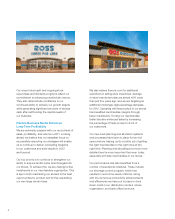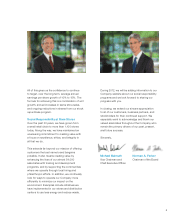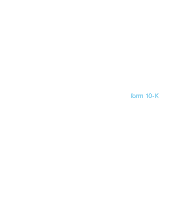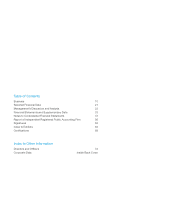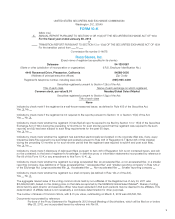Ross 2011 Annual Report Download - page 16
Download and view the complete annual report
Please find page 16 of the 2011 Ross annual report below. You can navigate through the pages in the report by either clicking on the pages listed below, or by using the keyword search tool below to find specific information within the annual report.14
dd’s DISCOUNTS
At January 28, 2012, we operated 88 dd’s DISCOUNTS in seven states: 48 in California, 19 in Texas, 12 in Florida, four in Arizona,
two in Georgia, two in Nevada, and one in Maryland. At January 29, 2011, we had 40 dd’s DISCOUNTS stores in California,
14 in Texas, seven in Florida, and two each in Arizona, Georgia, and Nevada, for a total of 67 stores. dd’s DISCOUNTS targets
the needs of households with more moderate incomes than Ross customers. We believe this is one of the fastest growing
demographic markets in the country. dd’s DISCOUNTS features a moderately-priced assortment of first-quality, in-season, name
brand apparel, accessories, footwear, and home fashions at everyday savings of 20% to 70% off moderate department and
discount store regular prices.
The dd’s DISCOUNTS business generally has similar merchandise departments and categories to those of Ross, but features
a different mix of brands at lower average price points. The typical dd’s DISCOUNTS store is located in an established shopping
center in a densely populated urban or suburban neighborhood. The merchant, store, and distribution organizations for
dd’s DISCOUNTS and Ross are separate and distinct; however, dd’s DISCOUNTS shares certain other corporate and support
services with Ross.
Available Information
The internet address for our corporate website is www.rossstores.com. Our Annual Reports on Form 10-K, quarterly reports on
Form 10-Q, current reports on Form 8-K, Proxy Statements, and amendments to those reports are made available free of charge
on or through the Investors section of our corporate website promptly after being electronically filed with the Securities and
Exchange Commission. The information found on our corporate website is not part of this, or any other report or regulatory filing
we file with or furnish to the Securities and Exchange Commission.
ITEM 1A. RISK FACTORS.
Our Annual Report on Form 10-K for fiscal 2011, and information we provide in our Annual Report to Stockholders, press
releases, telephonic reports, and other investor communications, including those on our corporate website, may contain forward-
looking statements with respect to anticipated future events and our projected financial performance, operations, and competitive
position that are subject to risks and uncertainties that could cause our actual results to differ materially from those forward-
looking statements and our prior expectations and projections. Refer to Management’s Discussion and Analysis for a more
complete identification and discussion of “Forward-Looking Statements.”
Our financial condition, results of operations, cash flows, and the performance of our common stock may be adversely affected
by a number of risk factors. Risks and uncertainties that apply to both Ross and dd’s DISCOUNTS include, without limitation,
the following:
We are subject to the economic and industry risks that affect large retailers operating in the United States.
Our business is exposed to the risks of a large, multi-store retailer, which must continually and efficiently obtain and distribute
a supply of fresh merchandise throughout a large and growing network of stores. These risk factors include:
• An increase in the level of competitive pressures in the apparel or home-related merchandise industry.
• Changes in the level of consumer spending on or preferences for apparel or home-related merchandise.
• The impact from the macro-economic environment and financial and credit markets including but not limited to interest rates,
recession, inflation, deflation, energy costs, tax rates and policy, unemployment trends, and fluctuating commodity costs.
• Changes in geopolitical and geoeconomic conditions.
• Unseasonable weather trends that could affect consumer demand for seasonal apparel and apparel-related products.


